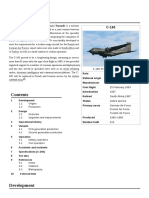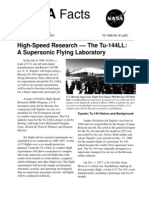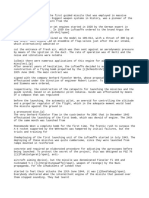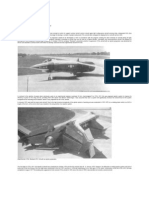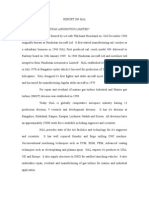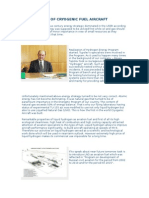Tupolev
Tupolev
Uploaded by
randomuse4Copyright:
Available Formats
Tupolev
Tupolev
Uploaded by
randomuse4Original Description:
Copyright
Available Formats
Share this document
Did you find this document useful?
Is this content inappropriate?
Copyright:
Available Formats
Tupolev
Tupolev
Uploaded by
randomuse4Copyright:
Available Formats
The Tupolev Tu-144 (NATO name: "Charger'") was the first commercial supersonic
transport aircraft (SST). It was one of only two SSTs to enter commercial service, the other being the
Anglo-French Concorde. The design, publicly unveiled in January 1962, was constructed in
the Soviet Union under the direction of the Tupolev design bureau, headed by Alexei Tupolev.
[1]
The prototype first flew on 31 December 1968 near Moscow,
[1]
two months before the first flight of
Concorde. The Tu-144 first went supersonic on 5 June 1969, and on 26 May 1970 became the first
commercial transport to exceed Mach 2. The frequent comparisons to Concorde led to the Tu-144
being known as "Konkordski" in the West.
[2]
A Tu-144 crashed in 1973 at the Paris Air Show, delaying its further development. The aircraft was
introduced into passenger service on 1 November 1977, almost two years after Concorde. In May
1978, another Tu-144 (an improved version, named Tu-144D) crashed in a test flight while being
delivered, and the passenger fleet was permanently grounded after only 55 scheduled flights. The
aircraft remained in use as a cargo plane until 1983, by which point a total of 102 commercial flights
had been completed. The Tu-144 was later used by the Soviet space programme to train pilots of
the Buran spacecraft, and by NASA for supersonic research.
The Soviet government published the concept of the Tu-144 in an article in the January 1962 issue
of the magazine Technology of Air Transport. The air ministry started development of the Tu-144 on
26 July 1963, 10 days after the design was approved by the Council of Ministers. The plan called for
five flying prototypes to be built in four years, with the first aircraft to be ready in 1966.
Despite the close similarity in appearance of the Tu-144 to the Anglo-French supersonic aircraft,
there were significant differences in the control, navigation and engine systems. The Tu-144 lagged
behind Concorde in areas such as braking and engine control. Concorde utilized an electronic
engine control package from Lucas, which Tupolev was not permitted to purchase for the Tu-144 as
it could also be used on military aircraft. Concorde's designers used airliner fuel as coolant for the
cabin air conditioning and for the hydraulic system (see Concorde for details). Tupolev installed
additional equipment on the Tu-144 to accomplish this, increasing the weight of the airliner.
Andrei A. Tupolev
[1]
continued to improve the Tu-144 with upgrades and changes on the Tu-144
prototype. While both Concorde and the Tu-144 prototype had ogival delta wings, the Tu-144's wing
lacked Concorde's conical camber. Production Tu-144s replaced this wing with a double-delta wing
including such conical camber,
[citation needed]
and they added a simple but practical device: two small
retractable canard surfaces, one on either side of the forward section on the aircraft, to increase lift
at low speeds.
Aeroflot Tu-144 at the Paris Air Show in 1975.
Moving the elevons downward in a delta-wing aircraft increases the lift, but also pitches its nose
downward. The canards cancel out this nose-downwards moment, thus reducing the landing speed
of the production Tu-144s to 315333 km/h (196207 mph; 170180 kn), still faster than that of
Concorde.
[3]
The NASA study lists final approach speeds during Tu-144LL test flights as 315
335 km/h (196208 mph; 170181 kn), however these were approach speeds exercised during test
flights specifically intended to study landing effects at maximum possible range of speeds,
regardless of how hard and stable the landing can be. As to regular landings, FAA circular lists Tu-
144S approach speed as 329 km/h (204 mph; 178 kn), as opposed to Concorde's approach speed
of 300 km/h (190 mph; 160 kn), based on the characteristics declared by the manufacturers to
Western regulatory bodies.
[4]
It is open to argument how stable the Tu-144S was at the listed
airspeed. In any event, when NASA subcontracted Tupolev bureau in the 1990s to convert one of
the remaining Tu-144D to a Tu-144LL standard, the procedure set by Tupolev for landing defined
the Tu-144LL "final approach speed... on the order of 360 km/hr depending on fuel weight."
[5]
Brian
Calvert, Concorde's technical flight manager and its first commercial pilot in command for several
inaugural flights, cites final approach speed of a typical Concorde landing to be 287296 km/h (178
184 mph; 155160 kn).
[6]
The lower landing speed compared to Tu-144 is due to Concorde's more
refined design of the wing profile that provides higher lift at low speeds without degrading supersonic
cruise performance a feature often mentioned in Western publications on Concorde and
acknowledged by Tupolev designers as well.
Engines
Although studies showed that turbojet engines are highly desirable for supersonic airliners, none
were available. The Tu-144 prototype was therefore originally fitted with the inefficient Kuznetsov
NK-144 turbofan engines and consequently suffered from higher nacelle drag. While this permitted
early test flights, it did not permit cruising at Mach 2 withoutafterburner. A maximum cruising speed
of 2,430 km/h (1,510 mph; 1,310 kn) (Mach 2.29) was obtained with the afterburner.
[8]
This meant
that while Concorde could supercruise(maintain supersonic flight without using its afterburners), the
Tu-144 could not. Later work on the Tu-144S resolved this shortcoming.
[9]
The turbofan engines
suffered from heavy fuel consumption, and hence a limited range of about 2,500 km (1,600 mi;
1,300 nmi), far less range than the Rolls-Royce/Snecma Olympus 593 turbojet that powered
Concorde.
The first production Tu-144S displaying at the 1973 Paris Air Showon the day before it crashed. The aircraft's
planform and canards are clearly shown.
The Tu-144S model, of which nine were produced, featured the Kuznetsov NK-
144F turbofan engines that offered better fuel efficiency over the original engine. The four engines
each had a maximum afterburning thrust of 200 kilonewtons (45,000 lbf) and each had separate inlet
ducts in each nacelle and variable ramps in the inlets,
[10]
giving a cruising speed of 2,000 km/h
(1,200 mph; 1,100 kn) (Mach 1.88). This also gave it a longer range of 3,080 km (1,910 mi;
1,660 nmi), but still less than half the range of Concorde.
[11]
The final Tu-144D model of which six were produced was powered by the Kolesov RD-36-
51 turbojet. This gave the Tu-144D the ability to cruise at a comparable speed to Concorde at
2,124 km/h (1,320 mph; 1,147 kn) (Mach 2.0). The new engines also gave the Tu144D a much
longer range, 6,200 km (3,900 mi; 3,300 nmi) at half the full payload. Plans for an aircraft with a
range in excess of 7,000 kilometres (4,300 mi; 3,800 nmi) range were never implemented.
[12]
Espionage against and influence of Concorde
The development of the Tu-144 is closely related to industrial espionage against the French
company Arospatiale, which was (along with the British Aircraft Corporation - BAC) developing
Concorde. Sergei Pavlov, officially acting as Aeroflot's representative in Paris, was arrested in 1965
and was in possession of detailed plans of the braking system, landing gear and the airframe of
Concorde. Another agent named Sergei Fabiew, arrested in 1977, was believed to have obtained
the entire plans of Concorde prototype in the mid-1960s. However, these were just early
development versions and would not have permitted the USSR engineers to come up with their own
aircraft, but could have served as an indication of the work of Concorde design team. An espionage
theory involved the Anglo/French Concorde team, who knew that the Soviets intended to steal the
plans, and therefore put into circulation a set of dummy blueprints with deliberate design flaws.
[13][14]
Production
A total of 16 airworthy Tu-144s were built:
the prototype Tu-144, registration number 68001
a pre-production Tu-144S, number 77101
nine production Tu-144S, numbers 77102 to 77110
five Tu-144D models, numbers 77111 to 77115.
The last production aircraft, Tu-144D number 77116, was not completed and was left derelict for
many years on Voronezh East airfield. There was at least one ground test airframe for static testing
in parallel with the development of prototype 68001.
Although its last commercial passenger flight was in 1978, production of the Tu-144 did not cease
until 1984, when construction of the airframe was stopped and left partially complete.
Early flights
Early flights in scheduled service indicated the Tu-144S was extremely unreliable. During 102 flights
and 181 hours of freight and passenger flight time, the Tu-144S suffered more than 226 failures, 80
of them in flight. (The list was included in the Tu-144 service record provided by the USSR to BAC-
Arospatiale in late 1978, when requesting Western technological aid with the Tu-144, and probably
incomplete).
[22]
A total of 80 of these failures were serious enough to cancel or delay the flight.
After the inaugural flight, two subsequent flights, during the next two weeks, were cancelled and the
third flight rescheduled.
[23]
The official reason given by Aeroflot for cancellation was bad weather
at Alma-Ata, however when the journalist called the Aeroflot office in Alma-Ata about local weather,
the office said that the weather there was perfect and one aircraft had already arrived that morning.
Failures included decompression of the cabin in flight on 27 December 1977, and engine exhaust
duct overheating causing the flight to be aborted and returned to the takeoff airport on 14 March
1978.
[22]
Alexei Tupolev, Tu-144 chief designer, and two USSR vice-ministers (of aviation industry and of civil
aviation) had to be personally present in Domodedovo airport before each scheduled Tu-144
departure to review the condition of the aircraft and make a joint decision on whether it could be
released into flight.
[24]
Subsequently, flight cancellations became less common, as several Tu-144s
were docked at Moscow's Domodedovo International Airport.
[citation needed]
Typical flight details
Tu-144 pilot Aleksandr Larin remembers a troublesome flight around 25 January 1978. The flight
with passengers suffered the failure of 22 to 24 on-board systems. Seven to eight systems failed
before takeoff; given the large number of foreign TV and radio journalists aboard the flight, and also
some other foreign notables aboard, it was decided to proceed with the flight in order to avoid the
embarrassment of cancellation.
After takeoff, failures continued to multiply. While the aircraft was supersonic en route to the
destination airport, Tupolev bureau's crisis center predicted that front and left landing gear would not
extend and that the aircraft would have to land on right gear alone, at the aircraft landing speed of
over 300 kilometres per hour (190 mph; 160 kn). Due to expected political
fallout, Soviet leader Leonid Brezhnev was personally notified of what was going on in the air.
With the accumulated failures, an alarm siren went off immediately after the takeoff with sound and
volume similar to that of a civil defense warning. The crew could not figure a way to switch it off and
the siren stayed on throughout the remaining 75 minutes flight. Eventually the captain ordered the
navigator to borrow a pillow from the passengers and stuff it inside the siren's horn. Luckily, all
landing gear extended and the aircraft was able to land.
[24]
The final passenger flight of Tu-144 on around 30 May 1978 involved valve failure on one of the fuel
tanks.
[24]
Limited routes
Suggesting low confidence of the Soviet decision-makers in Tu-144 is also the fact that only one
route was ever used, with flights limited to once a week, despite having eight Tu-144S certified
aircraft by the time passenger service commenced in 1977 and a number of routes suitable for
supersonic flights. Booking was limited to 7080 passengers a flight or less, well below the Tu-144's
seating capacity, despite waiting lists.
[25]
Over its 55 scheduled flights, Tu-144s transported 3,194
passengers, an average of 58 passengers per flight. With officials being acutely aware of the
aircraft's poor reliability and fearful of possible crashes, Soviet decision-makers were purposefully
limiting flight frequency to the absolute minimum possible that still allowed them to claim regular
service, and also were constraining passenger load to minimize the impact and political fallout of a
possible crash.
Airframe test failures
The most serious problem with the aircraft was discovered when two Tu-144S airframes suffered
catastrophic failures during laboratory testing just prior to the Tu-144 entering passenger
service.
[26]
This data is included as a chapter in Firdlyander's memoirs
[27]
and mentioned by Bliznyuk
et al. The problem, discovered in 1976 its return flight in June 1971 from a tour to Salon
Aeronautique coming back to Moscow via East Berlin and Warsaw.
[28]
In retrospect, the most fatal design decision for Tu-144 was the decision to assemble it from large
machined blocks and panels, many over 19 m (62 ft) long and 0.64 to 1.27 m (2.1 to 4.2 ft) wide.
While at the time, this approach was heralded as an advanced feature of the Tu-144 design
program, it turned out that large whole-molded and machined parts contained inconsistencies in the
alloys structure that cracked at stress levels below what the part was supposed to withstand. Once a
crack started to develop, it spread quickly for many meters, with nothing to stop it.
[26]
In 1976 during
repeat-load and static testing at TsAGI (Russia's Central Aerohydrodynamic Institute), a Tu-144S
airframe cracked at 70% of expected flight stress with cracks running many meters in both directions
from their origin.
[18][26]
Later the same year, a Tu-144 was subject to a test simulating heat and pressure conditions during
a flight. The Tu-144 was placed in a hyperbaric chamber and heated to 130150 C (270300 F).
Contraction and expansion happen because of the cooling during ascent and descent, heating
during supersonic acceleration and cruise and because of the pressure change from high altitude
(low outside pressure causing the airframe to expand) to ground-level pressure (causing it to
contract). The airframe cracked heavily and in a similar way as during TsAGI load testing.
[18][26]
While fatigue cracks are normal in aircraft, the usual occurrence is that a crack develops slowly and
stops once it reaches the end of the panel of which larger parts are assembled. Thus an aircraft
could fly with a minor crack for an extended time, until it could be fixed. The Tu-144 design was the
opposite of standard practice, fostering a higher incidence of non-uniformities in alloy structure
leading to crack formation and allowing a crack to develop fast and for many meters. Academician
Fridlyander, leading Soviet metallurgist and long-term collaborator of Tupolev since mid-1940s
through the 1990s, concludes his account of the Tu-144 program: "Airplane (the Tu-144) was
doomed as soon as the decision was made to compose it of large monolithic fragments machined of
large metal panels, this created its antipode, an unsafe, damageable design".
[26]
Decision to go back to passenger service
The Soviet leadership made a political decision to enter the Tu-144 into passenger service in
November 1977 despite receiving testing reports indicating that the Tu-144 airframe was unsafe and
not airworthy for regular service. Aeroflot appears to have thought so little of the aircraft that it did
not mention it in its five-year plan for 19761980. However, it was not the airline executives' decision
and Aeroflot reluctantly put the Tu-144 into passenger service on 1 November 1977.
Though the decision to cancel the Tu-144S passenger service came a few days after the Tu-144D
crashed during the test flight on 23 May 1978, this crash was regarded as the last straw over
mounting concerns about the reliability of the Tu-144. Even the fact that the technical reason for the
crash was specific to the Tu-144D fuel pump system and did not apply to the Tu-144S did not help.
The decision to pull the Tu-144S out of passenger service after merely 55 flights is thus more likely
to be attributable to high incidence of failures during and before the scheduled flights.
Cabin noise
One problem for passengers during flights was the very high level of noise inside the cabin. The
noise came partially from the engines and partially from the air conditioning and the aircraft skin
cooling system. Unlike conventional aircraft, this cooling system was absolutely vital for supersonic
cruise to cool off the aircraft skin, prevent it from overheating and losing structural integrity.
[citation
needed]
Heat generated by intense air-to-surface friction in supersonic flight is passed to the coolant
(cabin air, in case of both the Tu-144 and Concorde) and subsequently discharged via heat
exchangers to the fuel stream right before it is pumped to the engines. Unlike Concorde, the Tu-144
cooling system was very noisy. Passengers seated next to each other could have a conversation
only with difficulty, and those seated two seats apart could not hear each other even when
screaming and had to pass hand-written notes instead. Noise in the back of the aircraft was
unbearable. Alexei Tupolev acknowledged the problem to foreign passengers and promised to fix
it.
[29][N 1]
Seeking outside aid
There were unprecedented Soviet requests for Western technological aid with the development of
the Tu-144. The request was made despite obviously not helping to foster Soviet technological
prestige, which was one of the key purposes of the Tu-144 programme. In 1977 the USSR
approached Lucas Industries, a designer of the engine control system for Concorde, requesting help
with the design of the electronic management system of the Tu-144 engines, and also asked BAC-
Arospatiale for assistance in improving the Tu-144 air intakes. (The design of air intakes' variable
geometry and their control system was one of the most intricate features of Concorde, contributing to
its fuel efficiency. Over half of the wind-tunnel time during Concorde development was spent on the
design of air intakes and their control system.) In late 1978 the USSR requested a wide range of
Concorde technologies, evidently reflecting the broad spectrum of unresolved Tu-144 technical
issues. The list included de-icing equipment for the leading edge of the air intakes, fuel-system pipes
and devices to improve durability of these pipes, drain valves for fuel tanks, fireproof paints,
navigation and piloting equipment, systems and techniques for acoustical loading of airframe and
controls (to test against acoustic fatigue caused by high jet-noise environment), ways to reinforce the
airframe to withstand damage, firefighting equipment, including warning devices and lightning
protection, emergency power supply, landing gear spray guards (aka water deflectors or "mud flaps"
that increase engine efficiency when taking off wet airstrips).
[N 2]
These requests were denied after
the British government vetoed them on the ground that the same technologies, if transferred, could
be also employed in Soviet bombers.
[34][35]
Soviet approaches were also reported in British
mainstream press of the time, such as The Times.
Compressor disc failure in 1980
On 31 August 1980, Tu-144D (77113) suffered a compressor disc failure in supersonic flight leading
to further destruction of airframe structural elements and onboard systems. The crew was able to
perform an emergency landing at Engels-2 strategic bomber base.
[36][37]
On 12 November 1981, a Tu-
144D's RD-36-51 engine was destroyed during bench tests, leading to a temporary suspension of all
Tu-144D flights.
[37]
One of the Tu-144Ds (77114, aka aircraft 101) suffered a crack across the bottom
panel of its wing.
[38]
Economic inefficiency
Finally, the higher oil prices of the 1970s were starting to catch up with the Soviet Union. Much later
than in the West, but since the late 1970s, commercial efficiency was starting to become a factor in
aviation development decision-making even in the USSR.
[39]
The Tu-144 disappeared from Aeroflot
published prospects, replaced by the Ilyushin Il-86, a jumbo jet that was to become the Soviet
flagship airliner.
In the late 1970s, Soviet insiders were intensely hopeful in conversations with Western counterparts
of reintroducing Tu-144 passenger service for the 1980 Moscow Olympic games, even perhaps for
flights to Western Europe, given the aircraft's high visibility, but apparently the technical condition of
the aircraft weighed against such re-introduction even for token flights.
[39]
As discussed by Moon, economic efficiency alone would not have doomed the Tu-144 altogether;
continuation of token flights for reasons of political prestige would have been possible, if only the
aircraft itself would have allowed for it, but it did not.
[39]
The Tu-144 was to a large extent intended to
be and trumpeted as a symbol of Soviet technological prestige and superiority.
Cessation of Tu-144D production
The decision to cease Tu-144D production was issued on 7 January 1982, followed by a USSR
government decree dated 1 July 1983 to cease the whole Tu-144 programme and to use produced
Tu-144 aircraft as flying laboratories.
[18]
A formal decision to cease the Tu-144 programme was in all
likelihood related, to an extent, to the generational change in the Soviet leadership and departure of
those officials who had strong individual commitment to the Tu-144 and stakes in the project, and
corresponding change in the bureaucratic balance. The Tu-144 fared worse after the death of
Minister Petr Dementiev on 14 May 1977, but the last bureaucratic straw must have
been Brezhnev's death on 10 November 1982.
In retrospect, it is apparent that the Tu-144 suffered from a rush in the design process to the
detriment of thoroughness and quality, and this rush to get airborne exacted a heavy penalty
later.
[citation needed]
The rush is apparent even in outward timing: the 1963 government decree launching
the Tu-144 programme defined that the Tu-144 should fly in 1968; it first flew on the last day of 1968
(31 December) to fulfill government goals set five years earlier. (By the way of comparison,
Concorde's first flight was originally scheduled for February 1968, but was pushed back several
times until March 1969 in order to iron out problems and test components better).
[40]
Unlike Concorde
development, the Tu-144 project was also strongly driven by ideologically and politically motivated
haste of Soviet self-imposed racing against Concorde; Aleksei Poukhov, one of Tupolev's designers,
reminiscences: "For the Soviet Union to allow the West to get ahead and leave it behind at that time
was quite unthinkable. We not only had to prevent the West from getting ahead, but had to compete
and leapfrog them, if necessary. This was the task Khruschev set us... We knew that when
Concorde's maiden flight had been set for February or March, 1969, we would have to get our plane
up and flying by the end of 1968."
[N 3]
The Soviet way of thinking placed a great emphasis on
completing tasks on time, even if this meant the end product was rushed, crude, inefficient and
unsafe.
The introduction of the Tu-144 into passenger service was timed to the 60th anniversary of the
Communist revolution, as was duly noted in Soviet officials' speeches delivered at the airport before
the inaugural flight whether the aircraft was actually ready for passenger service was deemed of
secondary importance. Even the outward details of the inaugural Tu-144 flight betrayed the haste of
its introduction into service: several ceiling panels were ajar, service trays stuck, window shades
dropped without being pulled, reading lights did not work, not all toilets worked and a broken ramp
delayed departure half an hour. On arrival to Alma-Ata, the Tu-144 was towed back and forth for 25
minutes before it could be aligned with the exit ramp.
[41]
Equally telling is the number of hours spent
on flight testing. Whereas Concorde had been subjected to 5,000 hours of testing by the time it was
certified for passenger flight, making it the most tested aircraft ever,
[42]
total flight testing time of the
Tu-144 by the time of its introduction into passenger service was less than 800 hours. Flight testing
time logged on the prototype (68001) was 180 hours;
[43][44]
flight testing time for the Tu-144S until the
completion of state acceptance tests was 408 hours;
[45]
service tests until the commencement of
passenger service were 96 hours of flight time;
[46]
altogether totalling 756 hours. It is unclear why the
Minister of Aviation Industry and the Minister of Civil Aviation did not endorse the protocols of state
acceptance tests for four months after the tests completion.
[47]
One reason could be the change of
the guard Minister Dementiev, who was one of the chief backers of Tu-144, died a day before the
tests completed (something Gordon fails to notice) but it might also had something to do with
aircraft reliability record uncovered during the tests that was no better than the subsequent dismal
service record.
External factors contributing to project cancellation
Fridlyander points out that in addition to the Tu-144, Tupolev's bureau had to work on other projects,
including the Tu-154 passenger aircraft and the Tu-22M bomber. Despite large and high-priority
resource investment in the Tu-144 development programme and the fact that a large part of the
whole Soviet R&D infrastructure was subordinated to the Tu-144 project, parallel project
development overwhelmed the bureau causing it to lose focus and make design errors. (Design
errors affected not only the Tu-144, but the Tu-154 as well).
[39]
The first batch of 120 Tu-154s
suffered from wing destruction due to excessive structural load and had to be withdrawn.
[48]
The rushed introduction to service of poorly tested aircraft happened previously with another
Tupolev project that had high political visibility and prestige: the Tu-104 passenger jet liner that was
the first successful passenger jet airliner in service (the de Havilland Comet 1 was not considered
successful because four of the original nine aircraft crashed). In a decision-making similar to the Tu-
144 story, the Soviet government introduced the Tu-104 into passenger service before satisfactory
stability and controllability of the aircraft could have been achieved, despite the fact that during high-
altitude and high-speed flights the aircraft was prone to longitudinal instability, and also that at high
altitudes, it had a narrow range of angle of attack separating the aircraft from stalls known by
aviators as coffin corner. The effects of coffin corner however are not unique to Russian aircraft but
affect all aircraft. An example was how an Air France Airbus A330 in 2009 operating flight AF447
suffered a crash caused by these same issues.
[49]
These problems created the preconditions for spin
dives, that happened twice before the Tu-104 was eventually properly tested and the problem was
resolved.
[50]
This politically motivated rush, along with the fact that the project was essentially ideologically
motivated rather than driven by intrinsic needs of the Soviet society, and with general technological
insufficiencies of Soviet industrial base, contributed to the final undoing of the Tu-144 project.
(Alexander Poukhov, one of the Tu-144 design engineers who subsequently rose to be one of the
bureau's senior designers, estimated in 1998 that the Tu-144 project was 1015 years beyond the
USSR's capabilities at that time).
[N 4]
Moon suggests that subordination of available Soviet R&D resource allocation to the Tu-144
programme significantly slowed down the development of other Soviet aircraft projects, such as
the IL-86 wide-body jet, and stagnated Soviet aviation development for almost a decade.
[39]
After project cancellation
After ceasing the Tu-144 programme, Tu-144D No. 77114 (aircraft 101 or 08-2) carried out test
flights between the 1320 July 1983 to establish 13 world records registered with theFdration
Aronautique Internationale (FAI).
[52][53]
These records established an altitude of 18,200 metres
(59,700 ft) with a range of loads up to 30 tonnes, and a sustained speed of 2,032 km/h (1,263 mph;
1,097 kn) over a closed circuit of up to 2,000 km (1,200 mi; 1,100 nmi) with similar loads. The note
about loads, does not hold much significance as payload was compensated fuel load reduction to
maintain the same overall takeoff weight and the records for a closed circuit length, suggest that the
aircraft was only carrying a partial fuel load.
To put the numbers in perspective, Concorde's service ceiling under a typical Transatlantic
flight payload of 10 tonnes is 18,290 m (60,000 ft),
[N 5]
and this is higher than the record set by the
Tu-144D. According to unverified sources, during a 26 March 1974 test flight a Concorde reached its
maximum speed ever of 2,370 km/h (1,470 mph; 1,280 kn) (Mach 2.23) at an altitude of 19,415 m
(63,700 ft), and during subsequent test flights reached maximum altitude of 20,700 m (67,900 ft). It
is unclear why Tu-144D's maximum achievable altitude would be lower than Concorde's even
regular flight altitude, given that Tupolev's data claim better lift-to-drag ratio for the Tu-144 (over 8.0
for Tu-144D vs Concorde's 7.37.7 at Mach 2.x) and the thrust of the Tu-144D's RD-36-51 engines
is higher than Concorde's Olympus 593 engines.
[18]
Project in
English
Tupolev
Tu-144
Submitted by: Tarnate, Adrian Xavier S.
BS AMT 4B
Submitted to: Mr. A. J. Teves
You might also like
- AirlinersDocument264 pagesAirlinersAviation Library100% (1)
- ConcordeDocument3 pagesConcordeAlexandre RochaNo ratings yet
- Fatigue Failure of The de Havilland Comet 1Document8 pagesFatigue Failure of The de Havilland Comet 1Starfy the StarNo ratings yet
- NASA Facts Tu-144LL A Supersonic Flying Laboratory 1999Document4 pagesNASA Facts Tu-144LL A Supersonic Flying Laboratory 1999Bob Andrepont100% (2)
- Tupolev Tu - Docx Zack KKKDocument23 pagesTupolev Tu - Docx Zack KKKmuhammad azaniNo ratings yet
- English Tu 124Document18 pagesEnglish Tu 124titocosaaNo ratings yet
- 33 1rv18cv119 Umar BashirDocument10 pages33 1rv18cv119 Umar BashirUMARNo ratings yet
- EBSCO FullText 2024 07 30Document3 pagesEBSCO FullText 2024 07 30MiguelHRNo ratings yet
- Transall C 160Document10 pagesTransall C 160samirsamira928100% (1)
- IAF - Inducting The An-32 TransportsDocument6 pagesIAF - Inducting The An-32 TransportscheenuNo ratings yet
- Facts: High-Speed Research - The Tu-144LL: A Supersonic Flying LaboratoryDocument4 pagesFacts: High-Speed Research - The Tu-144LL: A Supersonic Flying LaboratoryNASAdocumentsNo ratings yet
- Bae Eap Zf534 Museum Accession Number X005-5992Document4 pagesBae Eap Zf534 Museum Accession Number X005-5992bob martinNo ratings yet
- Fieseler Fi 103 Flying BombDocument3 pagesFieseler Fi 103 Flying BombTimia TalashekNo ratings yet
- ConcordeDocument32 pagesConcordephutd09No ratings yet
- Contra Rotating04Document23 pagesContra Rotating04FireDesignNo ratings yet
- Ilyushin Il - 78Document16 pagesIlyushin Il - 78Anton MihailovNo ratings yet
- (ModelArt) XF5U-1 Flying Pancake (1-32)Document24 pages(ModelArt) XF5U-1 Flying Pancake (1-32)cerasella91100% (1)
- History of Concorde 4Document2 pagesHistory of Concorde 4utiputi355No ratings yet
- F 4U CorsairDocument24 pagesF 4U CorsairCliff Beaty100% (2)
- Rockwell XFVDocument5 pagesRockwell XFVdwaynefields100% (1)
- Hawkeye - Jan Van Waarde 2010Document29 pagesHawkeye - Jan Van Waarde 2010magyaralba100% (6)
- Tupolev Tu-160Document20 pagesTupolev Tu-160Big ZamNo ratings yet
- I.Ae. 22 DL: Technical Description: A Monoplane Build of Wood, Tandem TandemDocument8 pagesI.Ae. 22 DL: Technical Description: A Monoplane Build of Wood, Tandem TandemMartin PataNo ratings yet
- Dash 8 and SF-340Document3 pagesDash 8 and SF-340aeroengineer1No ratings yet
- UAV Unit 1Document23 pagesUAV Unit 1Akhil c.kNo ratings yet
- Aerial RefuelingDocument13 pagesAerial RefuelingMukesh Karunanethy100% (1)
- 2009 A 01Document7 pages2009 A 01Eric Cnes100% (1)
- Art Restoration 234 WorksheetDocument4 pagesArt Restoration 234 WorksheetDinas KesehatanNo ratings yet
- 1934 PARIS AIRSHOW REPORT - Part1 PDFDocument11 pages1934 PARIS AIRSHOW REPORT - Part1 PDFstarsalingsoul8000No ratings yet
- Config Aero Supersonic NotesDocument72 pagesConfig Aero Supersonic NotesManole Monik-AlexandraNo ratings yet
- Antonov - 32 Transport AircraftDocument6 pagesAntonov - 32 Transport AircraftShashank H R50% (2)
- Factual ArrowDocument16 pagesFactual ArrowBobby Chipping100% (3)
- Piper PA-34-220T G-BMNT 02-01Document10 pagesPiper PA-34-220T G-BMNT 02-01Jose A. HerreraNo ratings yet
- British Aerospace Hawk: Armed Light Attack and Multi-Combat Fighter TrainerFrom EverandBritish Aerospace Hawk: Armed Light Attack and Multi-Combat Fighter TrainerNo ratings yet
- ConcordeDocument13 pagesConcordeSathya Narayanan100% (1)
- Aerial RefuelingDocument20 pagesAerial RefuelingAbhijit MirajkarNo ratings yet
- Arado Ar 234Document12 pagesArado Ar 234moipedrasNo ratings yet
- Antonov AnDocument17 pagesAntonov AnLaurentius HaniNo ratings yet
- Report On HALDocument8 pagesReport On HALDIPAK VINAYAK SHIRBHATE100% (1)
- Air France Flight 447Document16 pagesAir France Flight 447Yanru WangNo ratings yet
- EA 6B BaugherDocument12 pagesEA 6B BaugherdemontisNo ratings yet
- The Tupolev Tu-144 Is A Four-Engine Supersonic Airliner For Up To 135 Passengers of The Soviettupolev Okb Design OfficesDocument2 pagesThe Tupolev Tu-144 Is A Four-Engine Supersonic Airliner For Up To 135 Passengers of The Soviettupolev Okb Design OfficesVimal ChandNo ratings yet
- 83-AF-1159 FMA PucaraDocument3 pages83-AF-1159 FMA Pucarazio_nanoNo ratings yet
- Book 4 - NASA Is Bringing Supersonic Planes Back 1Document46 pagesBook 4 - NASA Is Bringing Supersonic Planes Back 1Edema PrinceNo ratings yet
- Tu 22 MDocument82 pagesTu 22 MAitor Tillas FriasNo ratings yet
- WWW - Rvs.uni-Bielefeld - de Publications Incidents DOCS ComDocument37 pagesWWW - Rvs.uni-Bielefeld - de Publications Incidents DOCS ComCamarada RojoNo ratings yet
- NASA Facts D-558-IIDocument4 pagesNASA Facts D-558-IIBob AndrepontNo ratings yet
- Final DraftDocument4 pagesFinal Draftapi-271971379No ratings yet
- Airport Planning and DesigningDocument78 pagesAirport Planning and Designingayoushika abrolNo ratings yet
- Ii Iii Ii: - Li Imi MDocument1 pageIi Iii Ii: - Li Imi MwabeebdNo ratings yet
- Aircraft Operations From Runways With Inclined Ramps (Skijump)Document19 pagesAircraft Operations From Runways With Inclined Ramps (Skijump)hheussinger3893No ratings yet
- Antonov An225 MriyaDocument1 pageAntonov An225 MriyaMariana TymchyshynNo ratings yet
- Development of Cryogenic Fuel AircraftDocument6 pagesDevelopment of Cryogenic Fuel AircraftVincent S RyanNo ratings yet
- Bomber / Reconnaissance Aircraft: Arado Ar 234 (Blitz)Document3 pagesBomber / Reconnaissance Aircraft: Arado Ar 234 (Blitz)AtharvaShuklaNo ratings yet
- Supersonic Aircraft - WikipediaDocument52 pagesSupersonic Aircraft - WikipediaRc SkywardNo ratings yet
- Aircraft VNDocument52 pagesAircraft VNNguyễn Minh Quang100% (1)
- Aircraft of The Spanish Civil War Loire 46 and Me BF 109Document2 pagesAircraft of The Spanish Civil War Loire 46 and Me BF 109Timia TalashekNo ratings yet









